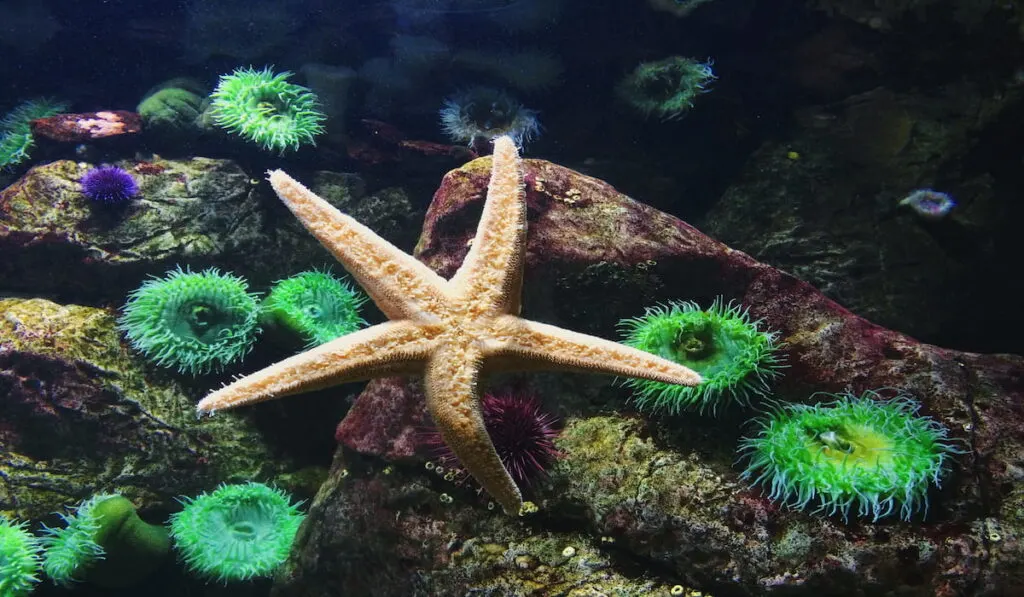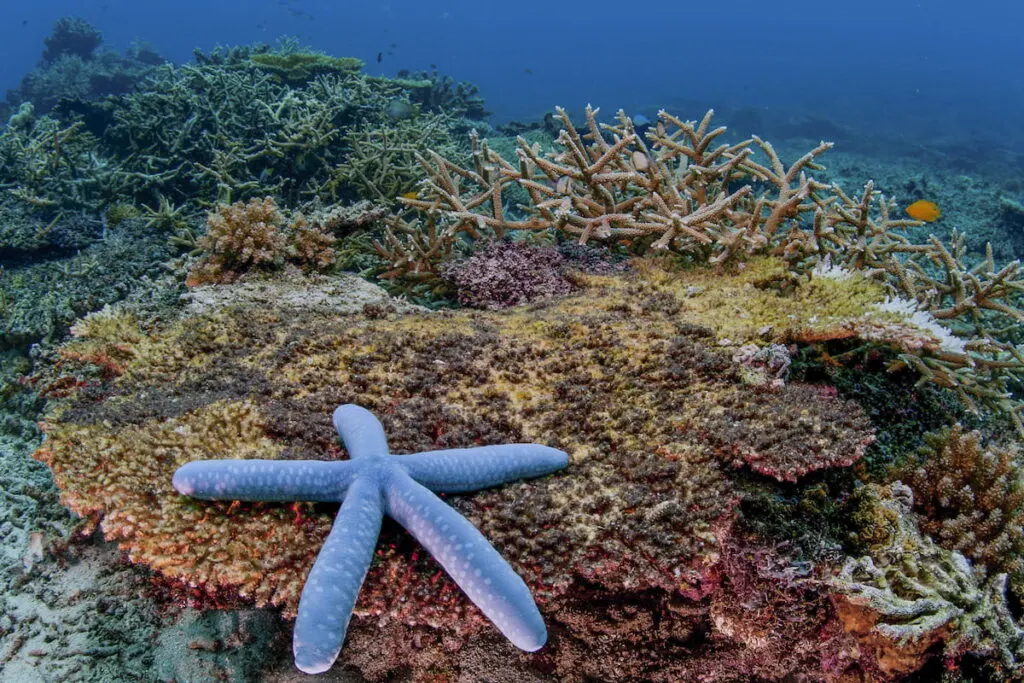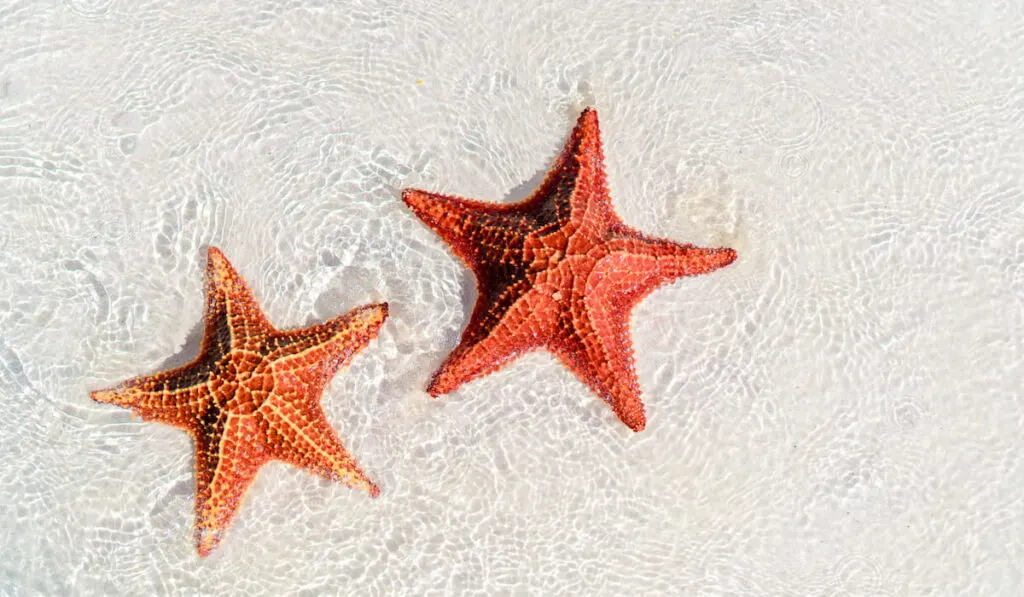Aside from a certain starfish of Spongebob Squarepant’s fame, when it comes to picturing starfish, they are not envisioned with distinctive eyes. Unlike fish and more like a sea slug, starfish are essentially faceless, lacking traditional distinguishing pieces, such as eyes, a nose or a strategically noticeable mouth. So you might wonder how they move around while staying aware of their surroundings. Do starfish even have eyes?
Starfish (most starfish, that is) do have eyes – though not where or how many you may expect. They have eye “spots” at the tip of each limb. Though rudimentary, they allow starfish to see and detect light. There are some exceptions to this, though, as a few species of starfish do not have these eye spots.

These starfish eyes are a far cry from the types of eyes we are used to seeing with our own eyes, but they help solve an age-old question about just how these guys get around and interact with their environment.
Table of Contents
How Well Can They See?
Starfish eyes are rudimentary, designed more for distinguishing between light and dark and for making out approximations of objects – they do not make out finer details or very solid outlines.
Because of this, starfish cannot see in color at all, as they lack those necessary cones. Also, their eyes aren’t designed to pick up on speedy motion, so fast-moving objects – their eye spots simply work too slowly.
When it comes to a field of view, though, researchers have been able to determine it is at least large enough to make out a coral reef, and about three feet in front of them. (source)
Researchers in Japan placed starfish in the daytime in a straight line at three feet back, six feet back and twelve feet back. The starfish that was three feet away was able to walk right back to the reef, while the ones at six and twelve feet just walked around aimlessly.
However, when this experiment was repeated at night, even the starfish three feet back struggled and walked in a random pattern, and their eyes cannot distinguish shapes well, so the darkness was rendering them essentially blind.
Because their peripheral is so wide, though, thanks to five points of sight all around them, if a starfish is in an open space, they have a full 360-degree view around them. When it comes to the images themselves, though, starfish eyes register sights crudely – at the approximation of around 200 pixels. (source)
How Do Starfish Eyes Work?

These eye spots on the starfish are, themselves, very small. (source)
If you were to look closely at the end of a starfish’s appendage, you may be able to see a small dot, black or red, about the size of a pen dot. That’s it – that’s the eye spot. Each little eye measures only around half a millimeter in width.
Eyes, when broken down, are a cluster of parts. Each arm of a starfish has a groove for the tube feet a starfish uses to move around are stored. At the end of each tube foot at the end of each arm lives the eye spot. And the spot itself is actually a structure made up of several hundred light-collecting units.
Think insect eyes or the eyes of lobsters – it is similar to that, though lacking in a lens to focus light, meaning these eyes really just take in and register lightness, darkness and general large items.
Those light-collecting units are called photoreceptors, and they do just as the name suggests: they have cells that react to and store light. (source)
Photoreceptors are a very primitive form of an eye (Anders Garn, a lead researcher on the study into starfish eyesight has said “even the best starfish vision is crude – about 500 times less acute than human vision”), but they are still an eye nevertheless.
The fact that the starfish reacts to the light and blurry shape cues collected by its eye spots also prove that they have a nervous system capable of processing and analyzing visual information.
What makes this extra impressive is that the starfish has no discernable brain in the traditional sense – or blood! (source) They take in, interpret and react to all outside influences solely through this incredible nervous system.
Since starfish eyes live on starfish arms, the starfish has access to a full range of vision based on some arm bends. Whereas our eyes are firmly set in place on our faces, we can only either shift our eyeballs or move our heads to take in our surroundings. Starfish, though, do all kinds of crazy contortions to allow them a full field of view. (source)
Often, starfish have been observed using their eyes like periscopes, bending their arms at a 90-degree angle. Other starfish, from the deeper and darker waters, take a page out of The Exorcist and bend their arms fully and completely backward, so they can look straight up and straight ahead to gauge light.
Regeneration: Arms and Eyes

You may have heard already about one of the coolest traits starfish have: the ability to regrow limbs. (source) Though sea star arms are very important, they are also designed to essentially tear away with ease.
This is so if a starfish finds its arm clamped onto by a predator or stuck under a fallen rock, they can jettison it like an ejector seat and swim away freely, saving themselves from death. (Like James Franco in 127 Hours but way less traumatizing.)
When a starfish loses an arm, though, it can regrow it. In fact, a starfish can lose up to four of its five arms and still regrow them all. As long as one-fifth of its central nervous system remains intact, a starfish can regrow almost a whole new body.
And when those arms regrow, they also regrow everything essential about them, including the tube feet and the eye spots. A starfish may temporarily lose full range of vision when losing an arm, but that arm, and that eye, will grow back with ease.
Did We Always Know Starfish Had These Hidden Eyes?
Nope! Though scientists have spent around two centuries aware of these arm tip eyes, for many years, since no traditional eyes could be found, scientists assumed that starfish guided themselves around the ocean by sense of smell. (source)
For an animal with fossil records dating back around 530 million years ago, being able to learn new information about them after all this time is actually pretty exciting.
And even the scientists in the past hundred or so years who knew these eyes existed could not do much with that information. It wasn’t until 2014 that science was evolved enough for researchers to be able to actually test the visual prowess of these eyes.
Building off of that first study involving starfish seeing and walking towards a coral reef, Garn took things a few steps further in the coming years to test starfish sight in deep, dark water.
One starfish used in the study was actually found to have no eyes at all. It was a sediment-dwelling creature and so had no evolutionary need to develop eyes. Instead, it actually does navigate by a sense of smell.
The other starfish who lived in that very dark environment, though, still had developed those appendage eye spots. Surprisingly, it was noted that some of those eyes were just as developed as the starfish who lived in shallower waters and therefore lighter conditions.
And two of those starfish were found to be bioluminescent (meaning they could glow), and so they worked as their own personal portable light source, searching out and attracting tasty bacteria mats to eat.
They were also thought to use that luminescence to deliver glowing signals to other starfish, so communicating by sight.
What’s more interesting is that one species who glowed fully all over their body also had some special eyes. Though still relatively primitive like other starfish’s eye spots, this species, the Novodinia americana, had large pupils as part of its eye structure that contracted and expanded more significantly when faced with changing light conditions. (source)
This means this starfish, in particular, is able to make out even sharper image outlines and details than other starfish that live in shallower water and therefore more light-filled environments.
What Role Does Light Detection Play in Starfish Behavior?

We already established that a starfish’s crude sight is useful for them in navigating their way around the sea and avoiding or interacting with large objects. But sight that is based on detecting light plays an even bigger part for them.
For one, following the light is helpful for starfish reproduction. (source) In shallower waters, starfish use pheromones (scents) to attract a mate. But in deeper waters, those scents simply cannot and do not travel very far, so that calling card is pretty much useless.
However, light particles can travel farther than a mere few inches, and so bioluminescence and an ability to pick up on that light is essential for starfish to find a mate and reproduce.
There’s also the ever-popular reason of simply finding food. Certain bacteria and algae glow, and so if a starfish can see that light source, they can eat that light source.
Starfish are often underestimated. Having no brain and no face can make them seem more decoration than animal, but they are actually very cool creatures. Not only can they see shapes and light, but they also process that information in ways that’s helped them adapt and survive for millions of years.
